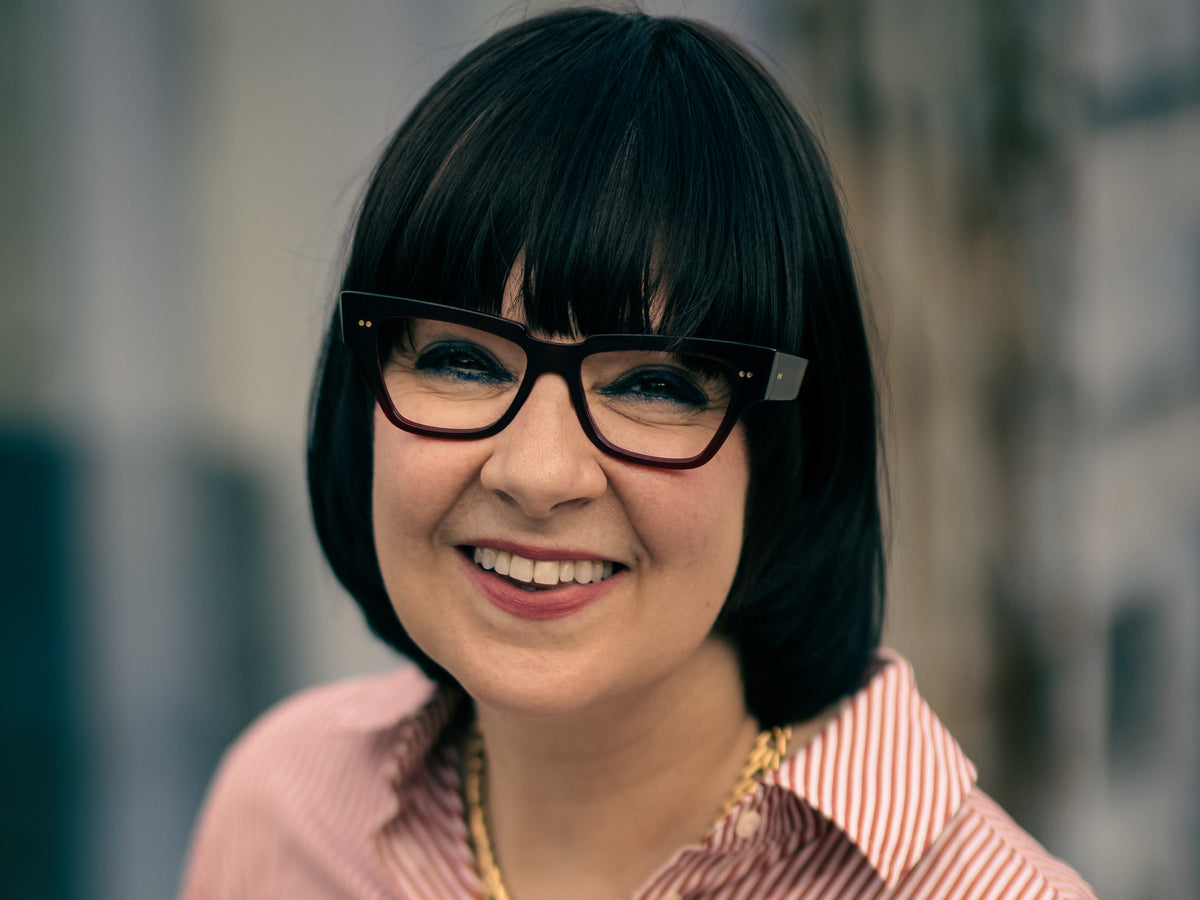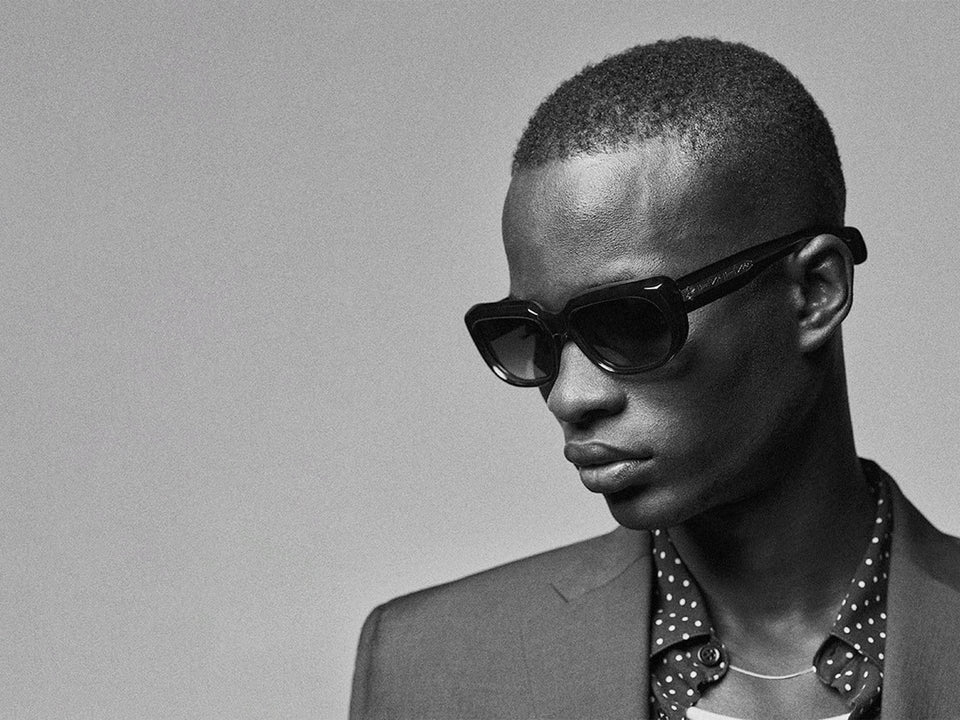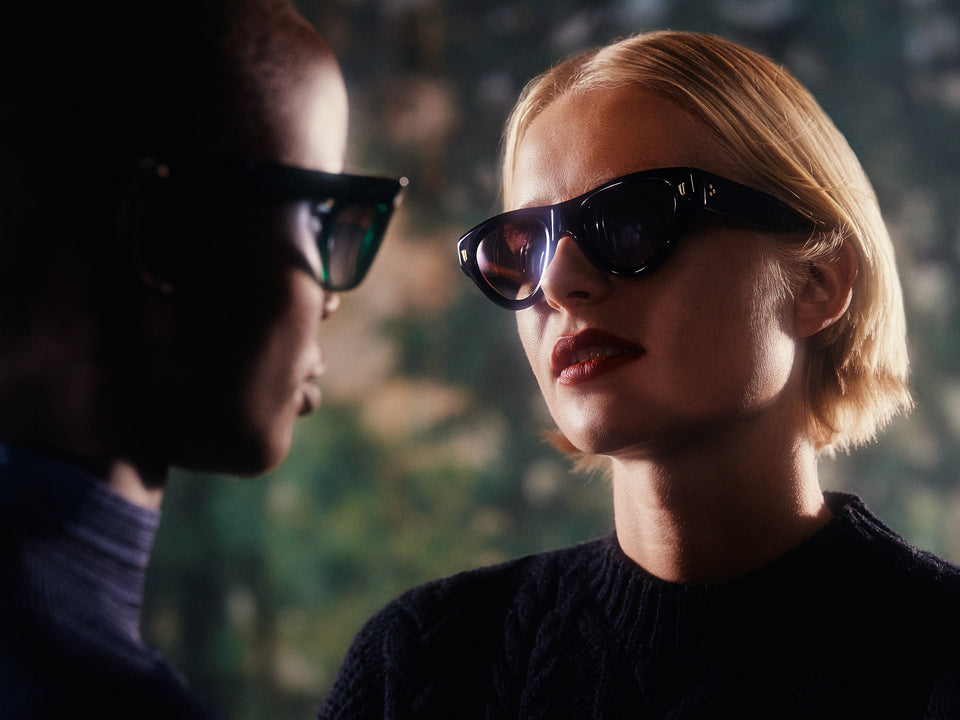Founded by optometrists Graham Cutler and Tony Gross back in 1969, it wouldn’t be an exaggeration to say that Cutler and Gross are probably one of the most legendary names in British eyewear.
Not many know as much about Cutler and Gross as Marie Wilkinson. She’s been with the brand since 1983, when she worked side by side with Mr Cutler and Mr Gross at their Knightsbridge shop. 40 years later, she’s still heavily involved, and after a long stint as Design Director, (working on collaborations with Comme des Garçons and The Rolling Stones to name just a few), she’s now the Style Director, managing the brand’s Spitalfields shop.
Seeing as our first delivery of Cutler and Gross frames has just arrived at Seen HQ, we thought it was a good time to catch up with Marie about the history of the brand and her life in the glasses-making world.
How did you get started working with glasses in the first place? Did you always want to work in fashion?
It began when I left my hometown in Romford, Essex and moved to London, where I started a part-time job working weekends at Baxendale’s Opticians. I wouldn’t say I always wanted to work in fashion but l I’ve always enjoyed experimenting with my own style and by working at Baxendale’s Opticians, I was able to explore another layer of fashion and my intrigue with the art of making glasses began.
“The Cutler and Gross customer has always been an individual. Eccentric maybe, but a rare breed, certainly”
You started working at Cutler and Gross back in the early 80s. What was it like working for the brand back then? You worked closely with Cutler and Gross at that point, didn’t you?
I began working with Mr Gross and Mr Cutler in 1983, alongside their frame maker George Smith and the receptionist, Kay Beck (widow of James Beck who played Private Walker in 'Dad’s Army'—so we made a lot of glasses for BBC folk too!)
At the time, the Knightsbridge store felt like working at a private members club, always filled with fascinating people including artists, musicians, and creatives alike—all recommended through word of mouth. It wasn’t just a store, it was a social hub for creativity where guests would drink coffee (provided by our neighbouring café owner Walter, who would bring cappuccinos around all day long) and smoke a cigarette whilst gossiping or discussing new projects and design ideas.
Each week Tony Gross would bring in a different photo of an artist wearing our latest frames, ready to display on our wall. There was never a dull moment, and it was utterly intoxicating!

Mr Cutler and Mr Gross
It sounds it. Whilst function was obviously important to Cutler and Gross, it seems like they really helped to move glasses away from being just practical items, and into a more stylish zone. What were they doing differently—why did their frames stand out?
During that time, a large frame manufacturing base had grown in the UK to support the making of NHS frames, however, the demand for this shifted around the mid-80s once NHS frames were no longer paid for by the government. With a new audience now looking to explore the field of eyewear, Cutler and Gross became a bright beacon of creativity amongst utility eyewear offering the luxury of handmade craftsmanship.
Whilst the usual offer of frames was limited, being either gold filled with black hoods or NHS frames, we established ourselves from other eyewear designers by making frames in bold profiles and vivid perspex colours such as crystal and tortoiseshell. Cutler and Gross design references were inspired by our customers and charismatic personalities, whilst function and fit remained a core pillar of our designs—and do to this day—our frames oozed personality, sex appeal and were not for the meek.

Perfectly paired - Cutler and Gross's 1396 in Black on Camo
You’ve worked at the brand for 40 years now—how has your role changed since the 80s?
Over the past 40 years, my role in the company has spanned across retail and merchandising, design and creative direction. I have been fortunate to work for a brand that always keeps innovating and has strong relations and loyalty from their customers. As Graham once said, “The Cutler and Gross customer has always been an individual. Eccentric maybe, but a rare breed, certainly”. Having interactions with our amazing customers never allows for a dull day. I am now Style Director dedicating my time and focus to supporting our retail teams and currently managing the Spitalfields store in London.
With each role I have used the experience to enhance the next. Being a dispensing optician trained by Mr Cutler—who is a stickler for well-fitting frames—has informed how I select frames for customers and even to how the store is merchandised.
When I started in 1983 at the Knightsbridge store, Cutler and Gross were at an important point in its history. As specialists in bespoke frame-making for the visually challenged, Tony Gross had ambitions to grow the business and sell to a broader audience, including his favourite kind of people—fashion people. Back at the store, we’d be tending to customers like Ava Gardner, Bryan Ferry, and Grace Jones.
To start the customers did not want me to help them; I was new and of course, the customers were there only to see Mr Cutler and Mr Gross as much for their wonderful conversation and gossip as well as the glasses! Seeing Tony and Graham with the customers was the best education I could get and I applied myself to learning how to fit and adjust for comfort the fabulous oversized and ambitious bespoke frames. It was all rather theatrical! To this day we have a wonderful mix of customers.

Knightsbridge HQ - Cutler and Gross's first store opened in 1969
I know you worked very closely on collaborations during your time as Design Director—working with brands like Comme des Garçons and Maison Martin Margiela. Can you tell us a bit about that?
Working with the originators of these great brands is an extreme version of working as a dispensing optician—asking questions, listening and asking more questions to gain the understanding to create the glasses required, understanding colour, and provide the innovative solution which suits the person and the budget.
Working on collaborations with Comme des Garçons I met with Rei Kawakubo in London, Paris and Tokyo and without a common language we created an understanding of what was required for her Homme Plus glasses. For the Homme Plus collection jackets and sleeves were duplicated, so the frames had a hinged double front which flipped up to reveal a frame of contrasting colour underneath.
With Victoria Beckham, she approached glasses design the same as with her fashion; she wanted to know everything about glasses in order to be fully informed in design meetings. She had a strong aesthetic and was great to work with.
And then working on the frames in Kingsman, the first meeting with director Matthew Vaughn and lead Colin Firth was like being in a movie. Each designer from each of the disciplines—shoe makers, a shirt maker, a tailor and me—flew to Nice, France and checked into a tourist hotel and were then driven to a hotel in the hills. We were then transferred to another minibus and driven to a private house with security. Colin was there to meet us and Matthew was on Skype from LA.Cutler and Gross are opticians that are used to making glasses for a myriad of different types of people and tastes which demands an agility and imaginative approach to making eyewear
Why do you think the brand has endured for so long? Not many brands have maintained such a prestigious name for as long as Cutler and Gross.
The Cutler and Gross reputation precedes, as they say! For over 50 years now, we have been at the forefront of optical design—as trailblazers, disrupters and pioneers whose legacy has been much imitated, but never surpassed. Cutler and Gross didn’t just make glasses—they were optical architects in pursuit of a product so intrinsically iconic that no external logo or branding was necessary.
The alliance of Tony Gross’ flamboyance and flair and the meticulous, detail-driven characteristics of Graham Cutler provided the perfect foundation for the opening of the store in 1971. Since then, the commitment to quality, fit and well-designed frames has been a philosophy which has endured for over half a century and continues to shape the Cutler and Gross collections to this day.
In tune with our commitments to our customers, I believe Cutler and Gross have maintained its reputation because we value our customers, we understand what they want and offer high-quality services to create truly one-of-a-kind bespoke and handcrafted glasses and sunglasses—they are true ambassadors of Cutler and Gross.
From Ava Gardner to Michael Fassbender, the list of people who have worn Cutler and Gross frames is pretty impressive. Is there anyone you would say is the perfect example of the Cutler and Gross style?
Edward Enninful, Editor-in-Chief of British Vogue and European Creative Director of Vogue. As a prominent figure in the fashion industry who has worn our frames for many years, he has adopted Cutler and Gross styles 0822 and 0676 as his own and wears them in a contemporary way. There is an ease with which he wears them, and I think this is key to the glasses seeming right for him.

Pick of the bunch - Cutler and Gross's 9288 in Emerald Green
Whilst the brand definitely keeps things moving, it’s also got a very good grasp of history and respect for its past. Is it difficult to do both at once? Or do they both feed into each other?
Cutler and Gross are opticians that are used to making glasses for a myriad of different types of people and tastes which demands an agility and imaginative approach to making eyewear; in parallel runs the factory with their innovations in technology so there is never a question of designs standing still but constantly evolving and improving.
Our Creative Director and his team root their research in the brand’s extensive 50+ year design archive. They then work hard to modernise the frames for a modern audience. Having such an enviable design legacy ensures our brand DNA is always present throughout our collections.
Last question—I imagine you’ve got a pretty extensive collection of glasses… do you have a favourite pair?
My collection of glasses is one that is never edited; each pair represents a moment in time since 1970. They define what style was in fashion, the latest innovation in lenses and the colour of the clothes and colour of my hair at the time. I think that a good pair of glasses looks in tune with the wearer, fits perfectly and garners positive comments.







